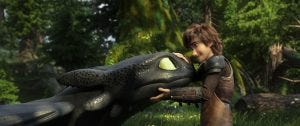How to Train Your Dragon: The Hidden World

The How to Train Your Dragon franchise is unlike any other animated series of recent memory. The series has managed to invest itself in not just a lore and mythology of mythic proportions, but also in how it handles the gradual evolution and maturity of its characters, particularly with its lead hero Hiccup Haddock III, so much so that it has spawned not only two sequels, but also a television series on Cartoon Network and Netflix. Rarely do we see an animated series that is capable of rivaling those of Pixar and the sort as far as popularity and quality goes, and How to Train Your Dragon: The Hidden World cements it as such, bringing this nearly decade-long journey to a visually breathtaking and emotionally gratifying conclusion.
It is now one year since the events of How to Train Your Dragon 2. Hiccup (Jay Baruchel) is now the chief of his village of Berk, where humans and dragons alike now live amongst one another in a utopia of sorts. At the same time, Hiccup alongside Toothless and his rag tag group of friends continue to search for captured dragons and rescue them. But after realizing that overcrowding has become a central issue for the people of Berk, Hiccup sets of to find the “Hidden World,” a secret dragon utopia told only through legends. Simultaneously, Hiccup must come to grips with both Toothless’ new affection for a female fury while dealing with a new threat to the dragons.
Director Dean DeBlois has been a powerhouse within the franchise, acting as co-director in the first entry and the sole director of its sequel. Much like in those two, DeBlois exhibits a love, care, and passion for the material in the latest entry, with each frame filled to the brim with heart and charm. At an approximate 100 minutes, the film effortlessly glides through its story with commendable pacing and a kinetic energy that brings this immensely dense world to life. At the same time, DeBlois has succeeded in crafting stories that involve mature themes of family, sacrifice, love, and loyalty, and much of that is still present in this entry. But this time around, the story isn’t necessarily as complex as in the previous entries and feels more straightforward in its handling of its primary subject matter as well as some of its characters. We don’t experience as much depth
As a result, most of the characters are simply there to either push the story forward or help Hiccup in his emotional growth. That being said, those characters are nonetheless endearing and entertaining as hell to watch, consisting of the ever supportive Astrid (America Ferrera), the cocky Snotlout (Jonah Hill), the inquisitive Fishlegs (Christopher Mintz-Plasse), and the knuckleheaded Ruffnut (Kristen Wiig) and Tuffnut (Justin Rupple). Even the primary villain, the cold and calculating dragon hunter Grimmel the Grisly (F. Murray Abraham), can be seen in this way. He doesn’t have any depth and is simply there to serve Hiccup and his arc, but he’s still a fun antagonistic obstacle for our heroes to overcome and does actually help Hiccup’s progression as a character.
But where this film is light on story, it is heavy in emotion and maturity, and that’s why the film is all about Hiccup and Toothless. For years we have seen them evolve from a boy and his dog to great leaders of their own kind, both of which have responsibilities of their own, with Hiccup leading as chief and Toothless ruling as king. This film reminds us the level of depth the bond they share has achieved over the years as well as the maturity both have achieved gradually, and the direction DeBlois takes their relationship makes it all worthwhile and satisfying.
Both must experience achievement and sacrifice if they are to succeed, and DeBlois perfectly encapsulates the many ways in which both characters reflect one another in their responsibilities. In this story, Toothless meets a female Light Fury and through the course of the film tries to win her affection, and in doing so begins to realize his full potential as the king of dragons. At the same time, Hiccup must conflict with maintaining order in an already crowded human-dragon utopia as well as the idea of marrying his current girlfriend Astrid being constantly implied by everyone around him.
DeBlois also succeeds in enhancing the emotion behind the story by maintaining the visual storytelling element of the franchise, utilizing gorgeous animation and jaw-dropping visuals to . In some moments we witness dread and anguish as well as scenes that’ll make you cry tears of joy and sorrow alike, and the animation helps bolster those feelings into existence. There’s humanity in the animation and beauty in the visuals, from the epic action sequences to the intimately tender moments, and all of it joins together to create a vast environment that is charm, splendor, and beauty.
How to Train Your Dragon: The Hidden World signifies the end of an era in the most visually striking and emotionally satisfying way possible. Many of us were children when we first heard the names Hiccup Haddock and Toothless, and for almost 10 years we’ve grown alongside them in maturity and character. The story, like those before it, is epic in proportions and intimate in emotion. Many have decided to debate between this franchise and Toy Story as far as which is the superior animated trilogy. The way I see it, both accomplish many wondrous things, and with How to Train Your Dragon: The Hidden World, I’m excited to see what the next series will be that’ll rival both of them. But until then, much like Toy Story, it’s time to say goodbye to another journey.
https://www.youtube.com/watch?v=qLTDtbYmdWM&t=1s&w=585



